Recommended Blogs
What Is Accessibility Testing? A Comprehensive Guide
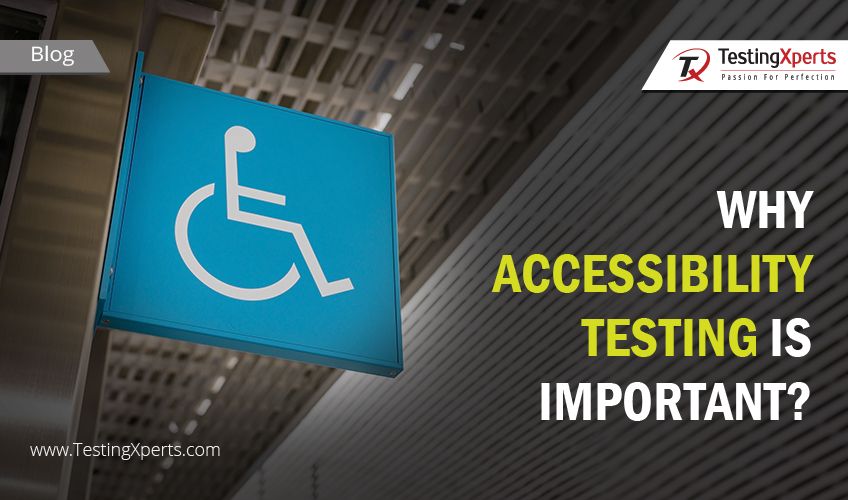
Table of Content
- Introduction: Why Accessibility Testing Matters
- What is Accessibility Testing?
- What Disability Challenges Do Accessibility Testing Address?
- Why Is Accessibility Testing Important?
- Web Accessibility Compliance Laws by Region
- A Glance at WCAG – Web Content Accessibility Guidelines
- A Detailed Checklist for Accessibility Testing
- Types Of Accessibility Testing
- How to Create Effective Test Cases for Accessibility?
- Practical Accessibility Testing Techniques
- Popular Accessibility Testing Tools
- Why Choose Tx for Accessibility Testing?
- Conclusion
Introduction: Why Accessibility Testing Matters
Over a billion people globally — around 16% of the world’s population — live with some form of disability. In today’s digitally driven world, where applications and websites are core to daily life, making digital platforms accessible isn’t just a regulatory checkbox — it’s a critical user experience imperative.
Accessibility testing is a structured process that ensures web and mobile applications are usable by everyone, including individuals with disabilities. It helps detect and eliminate barriers that prevent inclusive interaction, aligning with global standards like WCAG, ADA, and Section 508.
This guide explains accessibility testing, why it matters, how to implement it, and which tools and strategies will help you build inclusive, legally compliant digital products.
What is Accessibility Testing?
Accessibility testing is a software testing practice that verifies whether digital products (websites, mobile apps, and enterprise systems) are usable by individuals with various disabilities. These include:
- Visual impairments (color blindness, low vision, blindness)
- Auditory impairments (hearing loss, deafness)
- Cognitive/neurological disorders (dyslexia, ADHD, autism)
- Motor/physical disabilities (limited mobility, reliance on assistive devices)
The goal is to ensure that all users can navigate and interact effectively with digital interfaces, regardless of their abilities. Accessibility testing checks for compliance with accessibility standards such as the Web Content Accessibility Guidelines (WCAG) and ensures compatibility with assistive technologies like screen readers, voice input, and keyboard-only navigation.
What Disability Challenges Do Accessibility Testing Address?
Accessibility testing is designed to identify and eliminate barriers that prevent users with disabilities from effectively using digital products. It focuses on creating inclusive experiences by addressing challenges faced by people across a wide range of disability categories, including visual, auditory, cognitive, motor, and neurological impairments.
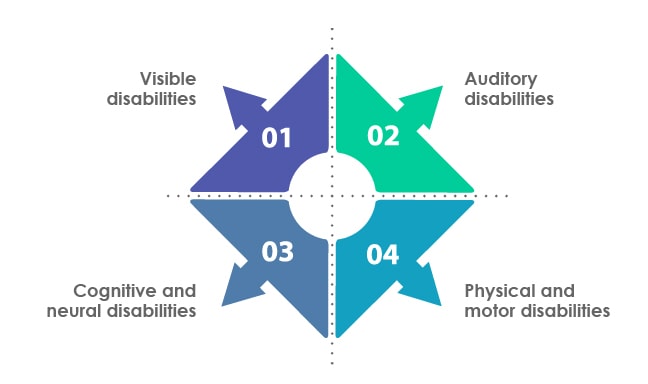
1. Visual Disabilities
These include partial or complete blindness, low vision, and color blindness. To support these users:
- Implement screen reader compatibility
- Ensure strong color contrast
- Add meaningful alt text to images
- Enable keyboard navigation
- Support braille displays
2. Auditory Disabilities
Users with hearing loss or deafness rely on:
- Video captions and audio transcripts
- Visual alerts and cues
- Sign language support where applicable
3. Cognitive and Neurological Disabilities
This includes users with ADHD, dyslexia, memory impairments, epilepsy, multiple sclerosis, etc. Accessible experiences for this group should offer:
- Clear, simple language
- Consistent navigation
- Text-to-speech compatibility
- Avoidance of flashing elements (to reduce seizure risk)
- Minimal cognitive load through reduced distractions and focused design
4. Motor and Physical Disabilities
Users with limited mobility, arthritis, muscular dystrophy, spinal cord injuries, or amputations benefit from:
- Full keyboard navigation (no mouse required)
- Voice command functionality
- Eye-tracking integration
- Larger clickable areas and flexible UI components
Why Is Accessibility Testing Important?
Accessibility testing is more than a compliance checkbox — it’s a strategic investment in inclusivity, user experience, brand reputation, and business growth. Here’s why it’s essential:
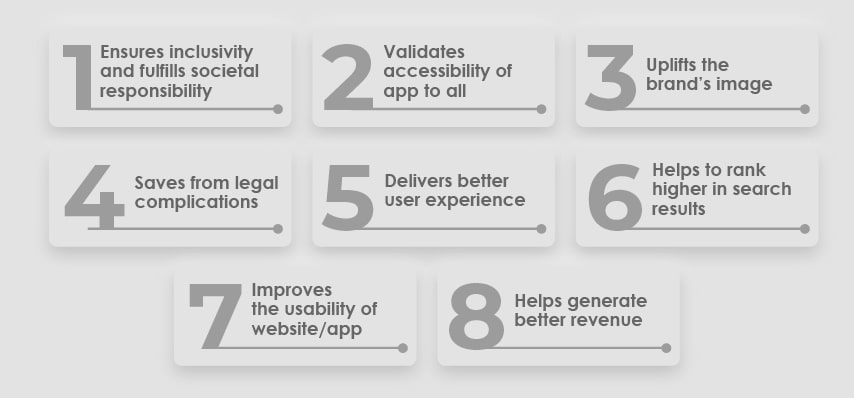
1. Ensures Inclusivity and Social Responsibility
Accessibility testing helps ensure that digital experiences are inclusive for everyone, including users with disabilities. By making apps and websites universally accessible, businesses fulfill a vital societal and ethical responsibility.
2. Validates Compliance with Accessibility Guidelines
Testing verifies that your product aligns with web accessibility standards like WCAG 2.1 and Section 508. It ensures that your digital platforms are usable by individuals with various disabilities, such as visual, auditory, cognitive, or motor.
3. Uplifts the Brand’s Image
When an app is accessible to all, it shows that a brand cares for its customers and ultimately helps to uplift the brand image.
4. Protects Against Legal Risks
Failure to meet accessibility standards can lead to lawsuits, fines, and reputational damage. Accessibility testing helps organizations avoid costly legal complications by proactively addressing compliance gaps.
5. Enhances User Experience for All
Accessible design benefits everyone, not just people with disabilities. Clear navigation, readable content, and multimedia alternatives improve usability for all users across devices and platforms.
6. Strengthens Brand Reputation
Inclusive design signals that your organization cares about all users. This builds trust, enhances brand perception, and strengthens customer loyalty, especially among underserved audiences.
7. Helps to Rank Higher in Search Results:
Search engines favor accessible websites. Implementing accessibility features like semantic HTML, proper headings, and alt text boosts your site’s crawlability and rankings on search engine result pages (SERPs).
8. Boosts Conversion and Revenue
Accessible websites reach a wider audience. By improving usability for all users — including those with disabilities — businesses increase engagement, reduce bounce rates, and improve conversion rates, directly impacting revenue.
Web Accessibility Compliance Laws by Region
Governments across the world have established digital accessibility regulations to ensure equal access for all users. Here’s a snapshot of key accessibility laws by region:
|
Region |
Law / Compliance |
Overview |
|
United States |
Americans with Disabilities Act (ADA) |
Requires businesses and organizations to make digital content (websites, mobile apps, etc.) accessible to people with disabilities. ADA compliance ensures equal access under civil rights law. |
|
United States |
Section 508 of the Rehabilitation Act |
Mandates all federal agencies and contractors to ensure accessibility of electronic content, documents, and IT systems for people with disabilities. |
|
United Kingdom |
Equality Act 2010 |
Requires digital service providers to make “reasonable adjustments” to ensure accessibility and prevent discrimination against people with disabilities. |
|
European Union |
Web Accessibility Directive |
Enforces accessibility for public sector websites and apps, requiring accessibility statements and feedback tools for users to report issues. |
|
Canada |
Accessibility for Ontarians with Disabilities Act (AODA) |
Requires public-facing organizations in Ontario to make websites, documents, and digital services accessible according to WCAG standards. |
|
Australia |
Disability Discrimination Act (DDA) |
Prohibits discrimination and requires both public and private sectors to offer equal access to digital content, services, and facilities. |
|
India |
Rights of Persons with Disabilities Act (RPwD), 2016 |
Requires government and private organizations to ensure that all electronic and IT systems are accessible to people with various disabilities. |
|
Italy |
Stanca Act |
It is an Italian law of 2004 that promotes the accessibility of information technology. This law applies to the Italian government websites and allows seamless access to all, including people with disabilities and special needs. |
A Glance at WCAG – Web Content Accessibility Guidelines
The Web Content Accessibility Guidelines (WCAG) are a globally recognized set of standards published by the Web Accessibility Initiative (WAI), part of the World Wide Web Consortium (W3C). These guidelines provide a framework for making web and mobile content more accessible to individuals with disabilities, including those with visual, auditory, cognitive, and motor impairments.
Designed to ensure content is compatible with assistive technologies and usable across devices (including mobile), WCAG is the foundation for accessibility compliance across multiple countries and legal frameworks.
WCAG Versions: 2.0, 2.1, and 2.2
- WCAG 2.0: Introduced in 2008, foundational version
- WCAG 2.1: Released in 2018, it introduced 17 new success criteria for users with low vision, cognitive challenges, and mobile accessibility needs
- WCAG 2.2: Finalized in October 2023, backward-compatible with 2.1, adds nine new success criteria and further supports keyboard and touch interaction
The Four Core Principles of WCAG
WCAG is built around four key principles, often referred to as POUR:
Perceivable
Information and user interface components must be presented in ways users can recognize, such as through alt text, captions, or adaptable layouts.
Operable
Navigation and UI elements must be functional via input methods like keyboard or voice control (e.g., skip links, focus indicators).
Understandable
Content and interactions must be transparent and predictable, such as form input validation, readable instructions, and logical sequences.
Robust
Content must be compatible with various technologies and assistive tools, including screen readers, browser extensions, and voice interfaces.
WCAG Conformance Levels: A, AA, AAA
Each WCAG guideline includes testable success criteria, grouped into three levels of compliance:
|
Level |
Definition |
Example Requirements |
|
Level A (Minimum) |
Basic accessibility support |
– Keyboard navigation |
|
Level AA (Standard target) |
Widely accepted for legal compliance |
– Color contrast ratio of at least 4.5:1 |
|
Level AAA (Highest) |
Enhanced usability for all users |
– Sign language for videos |
Note: Most organizations aim for WCAG 2.1 Level AA to meet accessibility laws such as the ADA, Section 508, AODA, and EN 301 549 (EU).
A Detailed Checklist for Accessibility Testing
A robust accessibility testing checklist ensures your website or application is inclusive, legally compliant, and user-friendly for people with diverse abilities. Below is a practical checklist aligned with WCAG 2.1/2.2, assistive tech compatibility, and global standards such as ADA, Section 508, AODA, and more.
1. General Accessibility Compliance
- Pages have unique and descriptive titles
- Headings are structured hierarchically (H1 > H2 > H3…)
- Content language is properly defined (<html lang=”en”>)
- No time-based content that auto-refreshes or disappears without warning
2. Text & Image Accessibility
- All images have meaningful alt text
- Decorative images are marked with empty alt (alt=””)
- Text contrast ratio is a minimum of 4.5:1 (Level AA)
- No content relies only on color to convey meaning
3. Keyboard Navigation & Focus Control
- All interactive elements (buttons, links, inputs) are accessible via the Tab key
- Focus indicators are clearly visible and follow a logical sequence
- No traps — users can navigate in and out of modals or pop-ups easily
- Skip-to-content links are available for keyboard users
4. Screen Reader & Assistive Tech Compatibility
- Form fields have associated <label> elements
- ARIA roles, landmarks, and states are used appropriately
- Alerts, status messages, and errors are announced by screen readers
- Page content updates dynamically are announced properly using ARIA live regions
5. Form & Input Accessibility
- Every input field has a visible and programmatically associated label
- Clear error messages are provided (both visually and for screen readers)
- Required fields are marked clearly
- Inputs provide autocomplete suggestions where appropriate
6. Mobile & Touch Accessibility
- Tap targets (buttons, links) are at least 44×44 pixels
- Gestures like swipe or pinch have keyboard alternatives
- No reliance on hover or mouse-only actions
- Responsive design works well across screen sizes
7. Audio, Video & Multimedia Content
- Captions are provided for all prerecorded videos
- Transcripts are available for audio-only content
- Sign language interpretation is available (Level AAA)
- Media controls are accessible by keyboard and screen reader
8. Document & File Accessibility (PDF, DOC, etc.)
- PDFs are tagged properly and readable by screen readers
- Document language and reading order are defined
- Tables use proper headings and scope attributes
- All non-text elements have meaningful alt text
9. Automated & Manual Testing Tools Used
|
Tool Type |
Example Tools |
Purpose |
|
Automated |
WAVE, Axe, AChecker, Lighthouse |
Detects basic WCAG violations |
|
Manual |
NVDA, JAWS, TalkBack, VoiceOver |
Verifies real-world assistive usability |
|
Browser Dev Tools |
Chrome DevTools, Firefox Accessibility Inspector |
Inspects ARIA roles, color contrast |
|
Mobile Tools |
VoiceOver (iOS), TalkBack (Android) |
Validates mobile accessibility on devices |
10. Legal Compliance Checks
- WCAG 2.1 AA conformance
- Section 508 (U.S.)
- ADA Title III (U.S. businesses)
- AODA (Canada), EN 301 549 (EU), RPwD Act (India)
- Accessibility statement presents on the site
- Feedback mechanism available for users to report issues
Pro Tip: Combine automated scans with manual testing and feedback from real users with disabilities to catch both visible and hidden accessibility issues.
Types Of Accessibility Testing
Accessibility testing is not a one-size-fits-all process—it involves multiple approaches depending on the platform, technology, and compliance requirements. Below are the most widely used types of accessibility testing to ensure inclusive, legally compliant digital experiences:
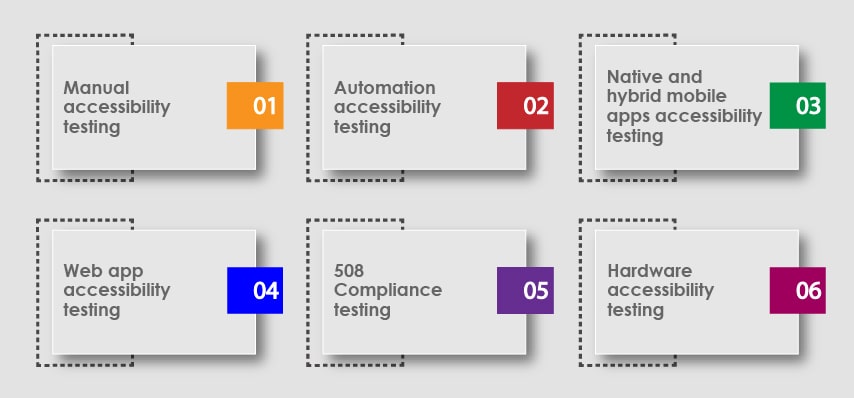
1. Manual Accessibility Testing
Manual testing involves human evaluation of digital content to detect accessibility barriers that automated tools might miss. Experienced testers, often including users with disabilities, validate websites and applications against WCAG guidelines through exploratory interaction.
Use Cases:
- Testing logical focus order
- Validating screen reader behavior
- Ensuring meaningful alt text and link labels
- Assessing cognitive load and readability
2. Automated Accessibility Testing
Automated accessibility testing uses software tools to quickly scan web pages or components to comply with WCAG 2.1, Section 508, and ADA standards. These tools identify common issues such as missing alt attributes, color contrast failures, and semantic errors.
Benefits:
- Speed and efficiency
- Early issue detection in the development cycle
- Scalable for large websites or apps
Limitations:
- Cannot detect contextual or user-experience-based issues
- Must be supplemented by manual testing
3. Web Application Accessibility Testing
This testing focuses on evaluating the accessibility of browser-based applications. It involves checking key components such as navigation, dynamic content updates, modals, dropdowns, and form interactions for WCAG conformance.
Key Factors Checked:
- Keyboard accessibility
- ARIA roles and labels
- Screen reader compatibility
- Content structure and readability
4. Mobile App Accessibility Testing (Native & Hybrid)
Accessibility testing for native and hybrid mobile apps ensures compliance on Android and iOS platforms. It includes validating gesture support, screen reader compatibility (TalkBack/VoiceOver), and UI adaptability.
Focus Areas:
- Touch target sizes
- Color contrast in various lighting
- Screen reader navigation
- Labeling of interactive elements
5. 508 Compliance Testing
Section 508 compliance testing ensures that federal digital content and software are accessible to users with disabilities. It requires checking for text equivalents, keyboard-only navigation, and the usability of multimedia elements.
Applicable To:
- U.S. government agencies and contractors
- Vendors providing digital content or tools to federal bodies
6. Hardware Accessibility Testing
This type of testing ensures that physical hardware devices and interfaces (e.g., kiosks, ATMs, POS systems) are usable by people with physical, visual, or motor impairments. It verifies accessibility in tandem with Section 508 and other global standards.
Examples Include:
- Evaluating tactile and audible feedback
- Compatibility with assistive devices
- Eye-tracking or voice command integration
Summary Tip: The most effective accessibility strategy combines manual and automated testing across all platforms—web, mobile, and hardware—to create fully inclusive and compliant user experiences.
How to Create Effective Test Cases for Accessibility?
Creating effective test cases is essential for ensuring that your web or mobile applications are truly accessible to users with diverse needs. Well-designed test cases validate conformance with WCAG guidelines and simulate real-world user behavior across multiple disability scenarios.
Here’s a detailed breakdown of how to structure accessibility test cases effectively:
1. Understand Accessibility Standards First
Review the Web Content Accessibility Guidelines (WCAG), ADA, Section 508, or other applicable laws based on your audience region. Understanding the four core principles—Perceivable, Operable, Understandable, and Robust (POUR)—is vital to building test scenarios that reflect compliance goals.
2. Map Test Cases to Real Disability Scenarios
Design test cases based on specific user groups:
|
Disability Type |
Sample Test Case |
|
Visual Impairment |
Verify that screen readers can announce form labels accurately. |
|
Color Blindness |
Check if charts or alerts are distinguishable without color cues. |
|
Motor Disabilities |
Ensure all form fields and menus are fully accessible via keyboard only. |
|
Cognitive Impairments |
Validate use of plain language, readable fonts, and structured navigation. |
3. Define Clear Test Objectives and Expected Outcomes
Every test case should include:
- A unique ID for traceability
- A description of what is being tested (e.g., keyboard navigation on the login page)
- Step-by-step actions
- The expected behavior (e.g., “Tab moves focus to the next interactive element”)
- Actual result and pass/fail status
Example:
- Test Case ID: A11Y-003
- Objective: Verify that the main navigation menu is accessible using a keyboard.
- Steps: Press Tab from page load. Check if each item receives focus in order.
- Expected Result: Focus moves sequentially across nav items with visible indicators.
4. Use a Mix of Positive, Negative, and Edge Cases
- Positive Cases validate correct implementation (e.g., alt text appears for all images).
- Negative Cases check error handling (e.g., missing alt tags trigger a warning).
- Edge Cases simulate unusual behaviors (e.g., sudden font zooming, screen reader + dark mode).
5. Integrate Assistive Technologies in Testing
Test cases should account for actual tools users rely on, such as:
- Screen Readers: JAWS, NVDA, VoiceOver
- Magnifiers: ZoomText, browser-based tools
- Speech Recognition: Dragon NaturallySpeaking, Windows Voice Control
You may include a column in the test case template to specify the assistive technology used.
6. Test Across Devices and Viewports
Accessibility doesn’t stop at desktop. Ensure your test cases cover:
- Mobile accessibility features (TalkBack, VoiceOver)
- Touch gestures and spacing
- Responsive UI behaviors for all screen sizes
7. Include Navigation and Interaction Cases
Some must-have test cases include:
- Navigating all interactive elements using Tab, Enter, Arrow keys, Shift+Tab
- Operating dropdowns, modals, and buttons without a mouse
- Validating focus traps and loop behavior in modals
- Ensuring skip navigation links work correctly
8. Document Results and Link to Fixes
Maintain a traceable log of:
- Test execution results
- Screenshots or screen recordings (for failed cases)
- Defect ID or JIRA link if issues are found
This creates a full audit trail for accessibility compliance.
9. Review and Iterate Regularly
Accessibility testing isn’t a one-time event. As features evolve, update test cases and expand them based on user feedback or changes in WCAG versions.
Pro Tip: Involve users with disabilities in beta testing—they provide unmatched insights into real usability challenges and help validate whether your test cases truly reflect practical accessibility.
Practical Accessibility Testing Techniques
To ensure digital products are truly inclusive, web accessibility testing solutions should go beyond checking for compliance. A practical approach combines manual and automated testing, real-user simulation, and assistive technology tools to uncover usability barriers that automated scanners might miss.
Here’s how to practically test accessibility throughout your development and QA lifecycle:
1. Manual Testing: Human-Led, Insight-Driven
Manual accessibility testing remains irreplaceable because some barriers can only be detected by humans—for example:
- Logical reading order and content flow
- Link context and button labeling
- Consistency of focus states
- Usability of interactive elements (modals, sliders, forms)
Tip: Use keyboard-only navigation (Tab, Shift+Tab, Enter, Space) to evaluate interactive elements across the site.
Checklist:
- Is the tab order logical?
- Are focus indicators visible?
- Can all elements be triggered without a mouse?
2. Automated Accessibility Testing Tools
Automation helps catch low-hanging accessibility issues early and efficiently, such as:
- Missing alt text
- Improper heading structure
- Poor color contrast
- Form label mismatches
Recommended Tools:
- axe DevTools (Chrome/Firefox extension)
- WAVE (Web Accessibility Evaluation Tool)
- Google Lighthouse (Built-in DevTools audit)
- Accessibility Insights
- AChecker
While these tools are great for initial audits, they should not be your only testing method. Combine them with manual review for a complete picture.
3. Screen Reader Testing
Screen readers simulate how users with visual impairments interact with web content.
Top tools:
- JAWS (Job Access With Speech) – Widely used on Windows
- NVDA (Non-Visual Desktop Access) – Free and open-source for Windows
- VoiceOver – Built into macOS and iOS
- TalkBack – Android screen reader
What to test with screen readers:
- Proper announcement of page titles, form fields, and buttons
- Logical reading order
- Accessibility of dynamic content (e.g., modals, AJAX)
4. Keyboard Navigation Testing
Many users rely solely on keyboards to navigate. Effective testing should ensure:
- All interactive components are focusable
- Navigation flow follows a logical order
- No keyboard traps (focus getting stuck)
Key checks:
- Skip-to-content links
- Focus indicators for dropdowns/modals
- Tab/Shift+Tab traversal across all elements
5. Color Contrast & Visual Clarity
Verify that the text is easily readable for users with low vision or color blindness. Use:
- Color Contrast Analyzers (like TPGi or WebAIM tools)
- WCAG’s minimum contrast ratio: 4.5:1 for normal text, 3:1 for large text
Also test:
- Zoom at 200% – Does layout break?
- Text rescaling – Is everything still readable?
- Color-only communication – Avoid using color as the sole means of conveying information (e.g., “red = error”)
6. Assistive Technology Testing
Broaden your test coverage by simulating how users interact with:
- Speech input tools (e.g., Dragon NaturallySpeaking)
- Screen magnifiers
- Alternative navigation devices (eye tracking, switches)
This provides real-world feedback beyond technical standards.
7. Cross-Browser & Cross-Device Testing
Accessibility can break due to inconsistencies in rendering or input behaviors.
Include tests across:
- Browsers: Chrome, Firefox, Safari, Edge
- Devices: Desktop, tablet, smartphone
- OS: Windows, macOS, iOS, Android
Bonus: Use emulators and real device farms (e.g., BrowserStack) for comprehensive testing.
8. Involve Users with Disabilities
Usability testing with real users offers unparalleled insight into barriers that might go unnoticed.
You can:
- Conduct moderated accessibility walkthroughs
- Observe navigation, comprehension, and form submissions
- Collect qualitative feedback on user comfort and confidence
Popular Accessibility Testing Tools
To build inclusive digital experiences, QA teams must use the right mix of manual tools, automation plugins, and screen reader simulators. Below is a categorized list of widely adopted accessibility testing tools used across web and mobile testing projects.
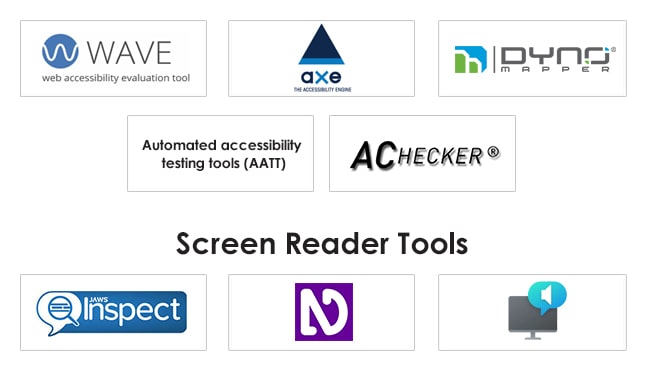
1. Automated Accessibility Testing Tools
Automated tools help detect common WCAG violations early in the development cycle, allowing teams to resolve issues proactively and improve compliance.
-
WAVE (Web Accessibility Evaluation Tool)
WAVE is a browser extension that visually identifies accessibility issues directly on a webpage. It evaluates HTML structure, color contrast, missing alt text, ARIA roles, and more. Available as Chrome and Firefox extensions, WAVE is user-friendly and ideal for quick, visual audits.
-
axe DevTools
Developed by Deque Systems, axe is a robust Chrome and Firefox plugin that scans for WCAG 2.0 and 2.1 issues. It works well on static and dynamic content, including password-protected pages, and integrates with Selenium and Cypress for CI/CD pipelines.
-
Dynomapper
Dynomapper is a visual sitemap generator that also offers accessibility testing. It performs content inventory, keyword tracking, and WCAG auditing across websites and web applications, enabling structured planning for accessibility remediation.
-
AATT (Automated Accessibility Testing Tool)
AATT is an open-source testing framework developed by PayPal. It uses HTMLCodeSniffer, PhantomJS, and Express to perform automated scans of single or multiple web pages. It’s ideal for enterprise teams integrating accessibility checks into existing QA workflows.
-
AChecker (Accessibility Checker)
AChecker is a customizable, open-source testing tool that supports URL-based and file-based WCAG testing. It allows testers to select standards like WCAG 2.0/2.1, Section 508, and Stanca Act and generates detailed issue reports across multiple conformance levels.
2. Screen Reader Testing Tools
Testing with screen readers is critical to ensure that visually impaired users can understand, navigate, and interact with your content seamlessly.
-
JAWS Inspect
JAWS Inspect enables testers to validate how JAWS (Job Access with Speech) interprets digital interfaces. It provides transcripts of the screen reader’s output, helping QA teams pinpoint non-compliant elements and improve user experience for visually impaired users.
-
NVDA (NonVisual Desktop Access)
NVDA is a free, open-source screen reader for Windows. It reads screen content aloud and supports interaction with many third-party apps. NVDA is commonly used to test screen reader compatibility across different UI components and web elements.
-
Windows Narrator
Built into Microsoft Windows OS, Windows Narrator reads on-screen content, such as buttons, text, and alerts, out loud. It’s useful for quick validation of keyboard navigation, form accessibility, and content readability from a visual impairment perspective.
To build inclusive digital experiences, QA teams must use the right mix of manual tools, automation plugins, and screen reader simulators. Below is a categorized list of widely adopted accessibility testing tools used across web and mobile testing projects.
Quick Comparison Table:
|
Tool Name |
Category |
Key Use Case |
|
WAVE |
Automated Audit |
Visual audits with on-page issue highlighting |
|
axe DevTools |
Automation Plugin |
Chrome-based quick scans + CI/CD testing |
|
Dynomapper |
Visual & Audit Tool |
Sitemap + WCAG checks for websites and apps |
|
AATT |
Automation Framework |
Custom scripts for scalable testing pipelines |
|
AChecker |
Open-Source Tool |
Manual entry of URLs/HTML files for WCAG audits |
|
JAWS Inspect |
Screen Reader Simulator |
Validates JAWS screen reader interpretation |
|
NVDA |
Screen Reader |
Free Windows-based tool for auditory testing |
|
Windows Narrator |
OS-Built Screen Reader |
Native Windows screen-reading accessibility testing |
Why Choose Tx for Accessibility Testing?
At TestingXperts (Tx), we combine deep domain expertise, advanced tools, and human-centered testing practices to ensure your digital platforms are accessible, inclusive, and fully compliant.
What Sets Us Apart:
- Standards-Centric Testing – We align our accessibility audits and testing with WCAG 2.1/2.2, ADA, Section 508, RPwD Act, Stanca Act, and other global standards.
- Certified Accessibility Specialists – Our in-house experts include individuals with disabilities and IAAP-certified testers who validate accessibility across real-world scenarios.
- Comprehensive Tool Expertise – From WAVE, axe, and AChecker to screen readers like NVDA and JAWS—we utilize both manual and automated tools for high accuracy.
- Mobile & Web Accessibility Coverage – We test native, hybrid, and responsive apps across Android, iOS, and web platforms to ensure end-to-end accessibility compliance.
- VPAT Report Delivery – Get detailed VPAT (Voluntary Product Accessibility Template) reports to support procurement and compliance documentation.
- Continuous Compliance Support – Accessibility isn’t one-and-done. We offer ongoing audits, re-validations, and accessibility lifecycle management.
Conclusion
In today’s digital-first world, accessibility is no longer optional—it’s a business, legal, and ethical imperative. Ensuring your websites, mobile apps, and digital platforms are usable by everyone, including people with disabilities, is critical for expanding your reach, enhancing user experience, and staying compliant with global standards such as WCAG, ADA, Section 508, and the RPwD Act.
Accessibility testing empowers organizations to identify and fix digital barriers early, promote inclusivity, avoid legal risks, and ultimately build trust with a broader audience. Whether you’re launching a new app or improving an existing platform, embedding accessibility into your QA strategy helps future-proof your digital products for all users—regardless of ability.
Discover more
